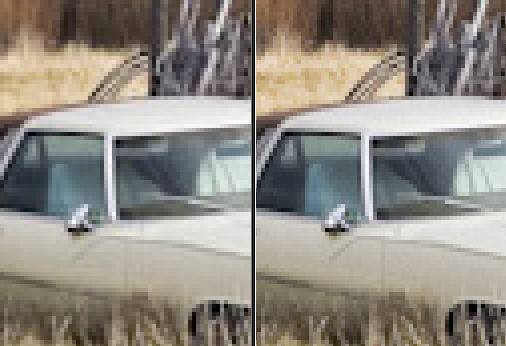Anytime you create a JPEG file using Lightroom’s Export dialog (or any other method), the file is compressed — information is thrown away in order to make the file smaller. How much is determined by the Quality setting or, in Lightroom 3 or later, if you choose instead, the Limit File Size setting.
The big benefit of JPEG files is that they are relatively small. The JPEG save algorithm is complicated, but it basically evaluates each pixel in your image, looking at pixels surrounding it to see if they are “close enough” in color and tone. If they are “close enough”, then they are changed to be the same. This way the file doesn’t need to store as many pieces of information and can be smaller. How close is “close enough” is determined by the Quality setting, which ranges from 0 to 100.
Here is an email-sized photo (approximately 400×600 pixels) saved at Quality=100:
And here is the same photo, saved at Quality=0:
Here is a close-up comparison (zoomed in to 4:1 / 400%, so you are seeing individual pixels in both):
In this case, the Quality=100 file is 298 kb, and the Quality=0 file is 79 kb. The file savings with each image will be different, based on the amount of detail in the image.
Note that even at Quality=100, information is being thrown away, but you would be hard-pressed to see any difference from your original or an uncompressed TIFF file. With this image, the TIFF would be 665 kb, so going with a JPEG at Quality=100 more than cuts the file size in half, with no visible loss in quality.
When I am emailing an image or putting it on the web, my goal is usually to get the smallest file possible, without visually degrading the image. I find that a quality setting of 60-70 is sufficient. For this image, Quality=65 reduces the file size to 135 kb, and the image looks fine:
If I zoom into 4:1 I can see some subtle differences, such as in the roof of the car, but they are not visible at 1:1, which is what I care about.
Unfortunately Lightroom’s export dialog doesn’t give you a preview of the result, so the only way to experiment is to do exports at various settings. You will find that higher quality settings are required for images with smooth areas with subtle transitions in color and tone, such as with skies, faces, and this car.
If I am sending an image out to print and the printer wants a JPEG rather than a TIFF (which is not compressed, and is therefore much bigger), then image quality becomes more important than file size to me. I will set quality at or close to 100. The file will be bigger, but it will be uploaded online or delivered in-person rather than emailed.
In Lightroom 3 the Limit File Size option was introduced as an alternative to using the Quality setting. Because each image is different, you can’t predict how big the file will be at any given Quality setting. The Limit File Size option is designed to overcome this. You can specify that the file must not exceed, say 500 kb, and Lightroom will use the highest quality setting possible that achieves that goal. I find this to be very handy when quality is really important to me but I need to put a cap on file size for whatever reason.
Experiment with the settings using your own images! On a Mac you can see how big the resulting JPEGs are by right-clicking on them (Ctl-click with a one button mouse) in Finder and choosing Get Info. On a PC you can right-click on them in Windows Explorer/My Computer and choose Properties.
Note that JPEG compression is the second major difference between shooting raw files versus shooting jpegs. You can fit more jpegs on your memory card because they are much smaller, but you will have lost information. If you choose the “large JPEG fine” settings in-camera, you may never notice the difference, but why give up information when you don’t have to?






